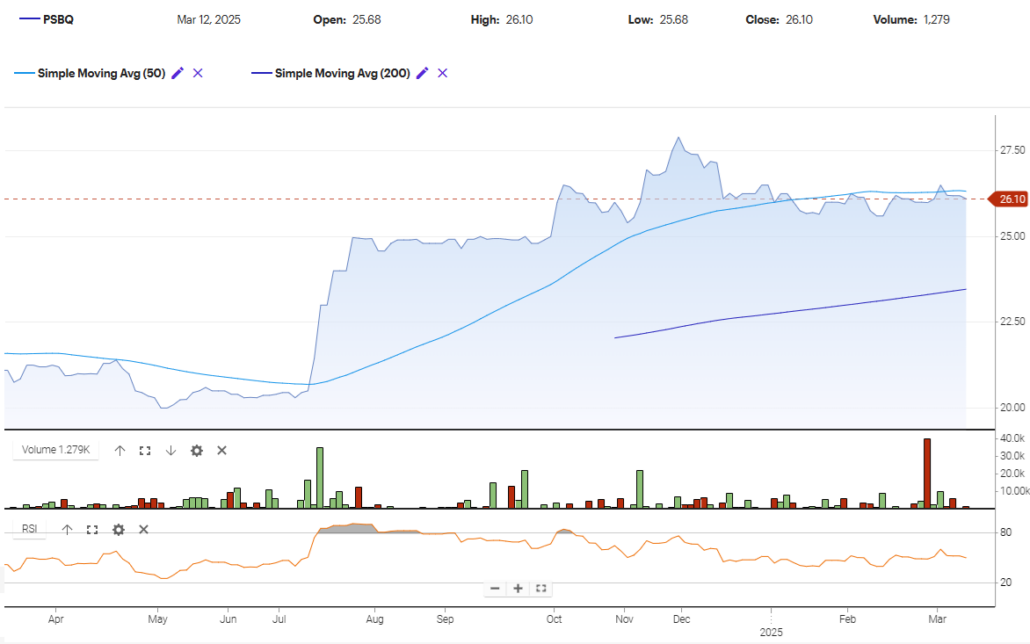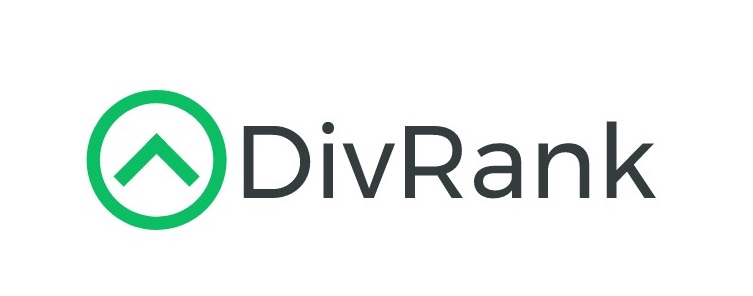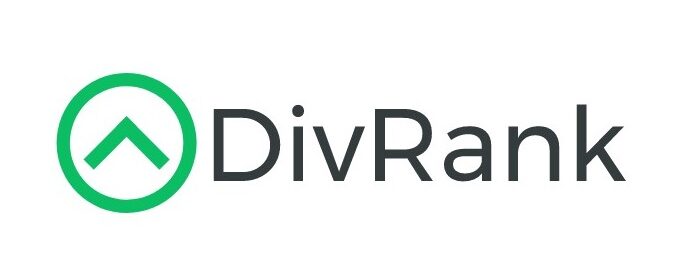Updated 3/13/25
PSB Holdings, Inc., the parent company of Peoples State Bank based in Wisconsin, is the kind of company that doesn’t make a lot of noise—but for patient, income-focused investors, that can be a real strength. This is a small-cap community bank with a market cap just over $100 million, and it’s built its business on relationships, consistency, and staying within its circle of competence.
Instead of chasing aggressive expansion or trying to compete with the big players, PSBQ sticks to what it knows. That approach has led to steady performance, conservative balance sheet management, and, for dividend investors, a payout that’s modest but consistently delivered.
Recent Events
There hasn’t been a flood of headlines around PSBQ, but that’s not a knock—especially in the banking world, where too much attention often means something went wrong. The bank wrapped up 2024 with a strong earnings report, showing nearly 30% growth in net income compared to the previous year and more than 10% growth in revenue.
The stock has also quietly climbed over the past year, rising more than 21%, which is a better showing than the broader market. Shares are now trading around $25.85, close to their 52-week high of $28. This performance, while under the radar, reflects solid investor confidence.
Key Dividend Metrics
📈 Dividend Yield: 2.48%
💵 Annual Dividend: $0.64 per share
🧱 Payout Ratio: 28.31%
📆 5-Year Average Yield: 2.18%
📊 Dividend Growth: Gradual but consistent
🏦 Next Dividend Date: January 31, 2025
⚠️ Ex-Dividend Date: January 10, 2025
🔁 Last Stock Split: 3-for-1 in August 2018
Dividend Overview
PSBQ’s dividend doesn’t scream for attention, but it doesn’t need to. The 2.48% yield might seem modest on the surface, but it’s comfortably above the company’s own five-year average and backed by a low payout ratio. That leaves room for both future increases and a safety cushion in tougher years.
For investors who prioritize consistency over flash, this kind of dividend track record is exactly what you want to see. The bank hasn’t missed a beat in terms of payments and continues to deliver quietly in the background.
Dividend Growth and Safety
When it comes to dividend safety, PSBQ checks a lot of the right boxes. The payout ratio sits under 30%, which suggests there’s no strain in maintaining the dividend. Earnings growth in the past year was strong, and the company is retaining most of its profits, a sign of fiscal discipline.
Dividend hikes over the years have been small, but they’re regular. That shows a pattern of careful stewardship rather than reckless generosity. It’s a pragmatic approach—prioritize the health of the business first, then return capital to shareholders when it’s sustainable.
This kind of discipline is especially important for banks, where profitability can be cyclical and credit losses can sneak up during downturns. PSBQ seems to understand that, and its management style reflects a focus on the long game.
Chart Analysis

Current Market Phase
Looking at PSBQ’s chart, the stock appears to be in the late stages of a markup phase, approaching what could be the early signs of distribution. The price made a strong move up between late June and early August, which was accompanied by a clear surge in volume. That sharp breakout from the earlier range marked the beginning of the markup. Since then, price has been moving in a more sideways pattern, showing signs of fatigue as it struggles to make new highs.
The flat trading zone from mid-November through March suggests potential supply entering the market. Each attempt to push higher has been met with selling pressure, indicated by the repeated failure to make new highs despite the supportive 50-day moving average. Volume during this phase has also declined overall, except for the occasional red spikes which imply some distribution underway.
Moving Averages
The 50-day simple moving average is currently flat, hugging the price closely. That shows consolidation. The longer-term 200-day moving average is still rising at a gentle pace, reflecting the prior strength in trend. The distance between the two has narrowed, hinting at a potential cross if price weakens further. That narrowing could become a more significant signal if followed by a sharp move lower.
Volume Analysis
Volume tells a very specific story here. During the breakout run in mid-2024, volume expanded sharply on green days, a classic hallmark of demand stepping in. But more recently, the red volume bars are growing, especially that large spike in March, which came with only a modest price move. That’s the kind of imbalance that signals selling into strength or smart money offloading into any upward pushes.
What’s missing is conviction on the buy side. Most green volume bars since December have been low in comparison to earlier rallies. That fading volume in the face of price stalling shows that buyers are becoming less aggressive.
RSI Behavior
The Relative Strength Index had a strong move into overbought territory in August, holding above 70 for a stretch before cooling off. Since then, RSI has steadily declined and is now hovering in neutral territory around 50. This confirms the weakening momentum. There’s no clear bullish divergence and the slope is flat, consistent with a stock that’s lost its upside momentum and could be preparing for a shift in phase.
Price Action and Latest Candles
Looking closely at the most recent five candles, they paint a picture of indecision. The wicks on both the top and bottom suggest tug-of-war between buyers and sellers. Most of these candles are small-bodied, reflecting reduced commitment from either side. The latest close at 26.10 is right where the price was in late January, which further supports the idea of consolidation and possible distribution.
The March 12 candle is particularly notable—it opened and closed at the same level, with no price movement in between. Combined with the very low volume on that day, it speaks to a lack of participation, a sign that investors are waiting for a clearer direction before stepping in.
This behavior—flat RSI, mixed volume, tightening price range, and low participation—often shows up at the end of a markup phase and just before a markdown begins, unless there’s a clear reaccumulation event to recharge the trend.
Analyst Ratings
📉 PSB Holdings, Inc. (PSBQ) operates under the radar of most major financial institutions, which means it doesn’t get the same level of analyst attention as larger banks. As of now, there haven’t been any recent formal upgrades or downgrades from big-name brokerage firms. That’s pretty typical for a small-cap, regional bank like this one.
📊 Because of the limited coverage, there’s no widely published consensus price target available. The few platforms that do weigh in on PSBQ tend to offer more generalized ratings rather than deep-dive analyses. One of those recently tagged the stock with a “Cautious Hold” rating. That doesn’t mean the business is struggling—more so, it reflects the cautious sentiment surrounding thinly traded regional banks right now, especially with shifting interest rate expectations and tight liquidity conditions in smaller markets.
🧾 The rationale behind the reserved rating comes down to a mix of valuation and momentum. After a strong run-up last year, PSBQ has been trading sideways for months. Some investors may see that as consolidation before a move, while others are waiting on clearer signs of renewed growth or a reacceleration in earnings.
📉 Trading volume is consistently light, which is another factor that may temper institutional enthusiasm. When you only see a few thousand shares change hands daily, it becomes difficult for bigger funds to build a meaningful position without moving the price.
💬 That said, this quiet environment could present opportunities for individual investors who are willing to dig into the fundamentals themselves. PSBQ’s balance sheet, dividend, and earnings growth still offer solid reasons to keep it on the radar—especially for income-focused portfolios looking beyond Wall Street’s spotlight.
Earning Report Summary
PSB Holdings wrapped up the final quarter of 2024 on a solid note, continuing its quiet but steady performance. The bank posted earnings of $0.73 per share for the quarter, which brought total annual earnings to $2.37 per share. That’s a nice jump from $2.16 the year before—roughly a 10% improvement year-over-year. It’s not flashy growth, but it’s consistent, and that kind of steady climb is exactly what you’d hope for from a conservative community bank.
What really helped this quarter was the bank’s core business—its net interest income grew to $10.4 million. That’s up from $9.9 million the previous quarter. They’ve been able to earn a little more on their loans and assets, while keeping funding costs in check. The result? A healthier net interest margin, which widened slightly. That shows they’re squeezing a bit more profitability out of each dollar they lend.
There was a bit of a dip on the non-interest income side, mostly due to a loss on securities they sold. That number fell by about half a million, landing at $1.3 million. It’s not ideal, but not a major red flag either. On the bright side, expenses came down slightly. Salaries and benefit costs ticked lower, helping total non-interest expenses drop to $8 million.
The bank’s loan book continues to grow, with a $20 million increase during the quarter, now totaling just over $1.08 billion. Most of that growth came from commercial real estate and construction loans. And they’re keeping a cautious eye on credit risk—the allowance for potential loan losses held steady at 1.13%. That’s a pretty healthy buffer for a bank of their size.
As for credit quality, it’s holding strong. Non-performing assets made up just 0.71% of total assets at year-end, which shows management is doing a good job keeping risky loans in check.
Tangible book value per share rose by 9% over the year, hitting $25.98. On the dividend front, they returned $0.64 per share to investors—up nearly 7% from the year before. That consistency matters, especially to income-focused shareholders.
The bank also made a strategic move in January 2025 by acquiring Larson Financial Group, a local advisory firm. It’s a smart play to broaden their services and deepen customer relationships going forward. All in all, it was a strong finish to the year with plenty of signs of quiet confidence heading into 2025.
Financial Health and Stability
Looking under the hood, PSBQ’s fundamentals paint the picture of a well-managed community bank. Return on equity is sitting at 9.12%, which is a solid mark for a bank of its size. Return on assets is more conservative at 0.71%, but again, this aligns with PSBQ’s low-risk strategy.
The bank has more than $40 million in cash on the books, translating to about $9.91 per share. That’s a strong liquidity position for a $25 stock. Debt levels are manageable, with total debt around $187 million, and while there’s no specific debt-to-equity figure provided, there’s no sign of overleverage.
Margins are another bright spot. Operating margin is north of 30%, and net profit margin is nearly 23%. Those figures are strong by any standard, and they suggest that PSBQ is doing a good job of converting revenue into profit without bleeding efficiency.
Valuation and Stock Performance
From a valuation standpoint, PSBQ looks like it’s still reasonably priced. The trailing P/E ratio sits at 11.8, which is lower than many peers in the financial sector and certainly well below the broader market average. Price-to-book is sitting just below 1.0, suggesting the stock is trading slightly under book value—a potential bargain if the business continues to perform.
Price-to-sales comes in at 2.43, a bit on the higher side for a bank, but not alarming given the revenue growth. The stock’s 52-week movement has been steady and impressive, and technicals confirm the strength: the 50-day moving average is above the 200-day, which signals a bullish trend.
The low beta of 0.25 is another point in the bank’s favor. This stock moves less than the broader market, which is exactly what income investors want from a long-term holding—less drama, more dependability.
Risks and Considerations
Of course, no investment is without its risks. PSBQ operates in a smaller, regional footprint, which makes it more sensitive to local economic changes. If the Wisconsin economy slows down or credit quality deteriorates in its markets, the bank could feel the impact more acutely than a larger, more diversified institution.
Liquidity is another factor worth noting. The average trading volume is quite low—just a couple thousand shares a day. For large investors, that makes buying or selling positions a little trickier and potentially more expensive.
Institutional ownership is also relatively light, sitting under 14%. That may limit analyst coverage and market visibility, which means this stock may continue to fly under the radar. That can be a good or bad thing, depending on your perspective.
And while the dividend is safe and consistent, it’s not high enough to satisfy income investors looking for 4% or 5% yields. This is a steady payout with a slow growth profile—not a cash cow.
Final Thoughts
PSB Holdings isn’t going to blow anyone away with high yields or aggressive growth. But that’s kind of the point. For income-focused investors who value safety, discipline, and consistency, this is the kind of stock that earns a quiet spot in a portfolio and just keeps delivering.
The financials are solid, the dividend is well-covered, and management runs a tight ship. There’s a conservative mindset here that should appeal to investors who prefer reliable cash flow over risky upside.
It’s the kind of stock you don’t hear much about—but one that just might prove its worth, year after year, as a calm and steady piece of a dividend strategy.

